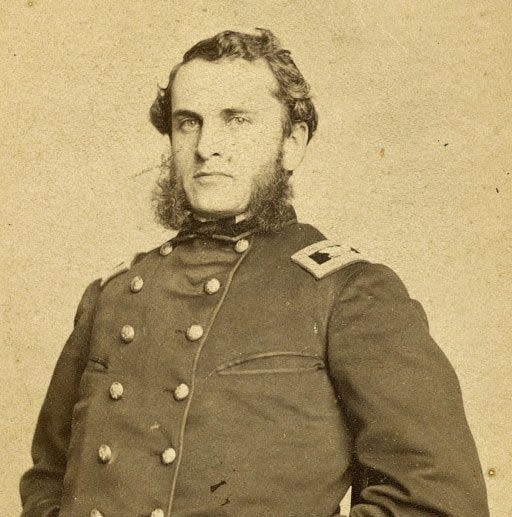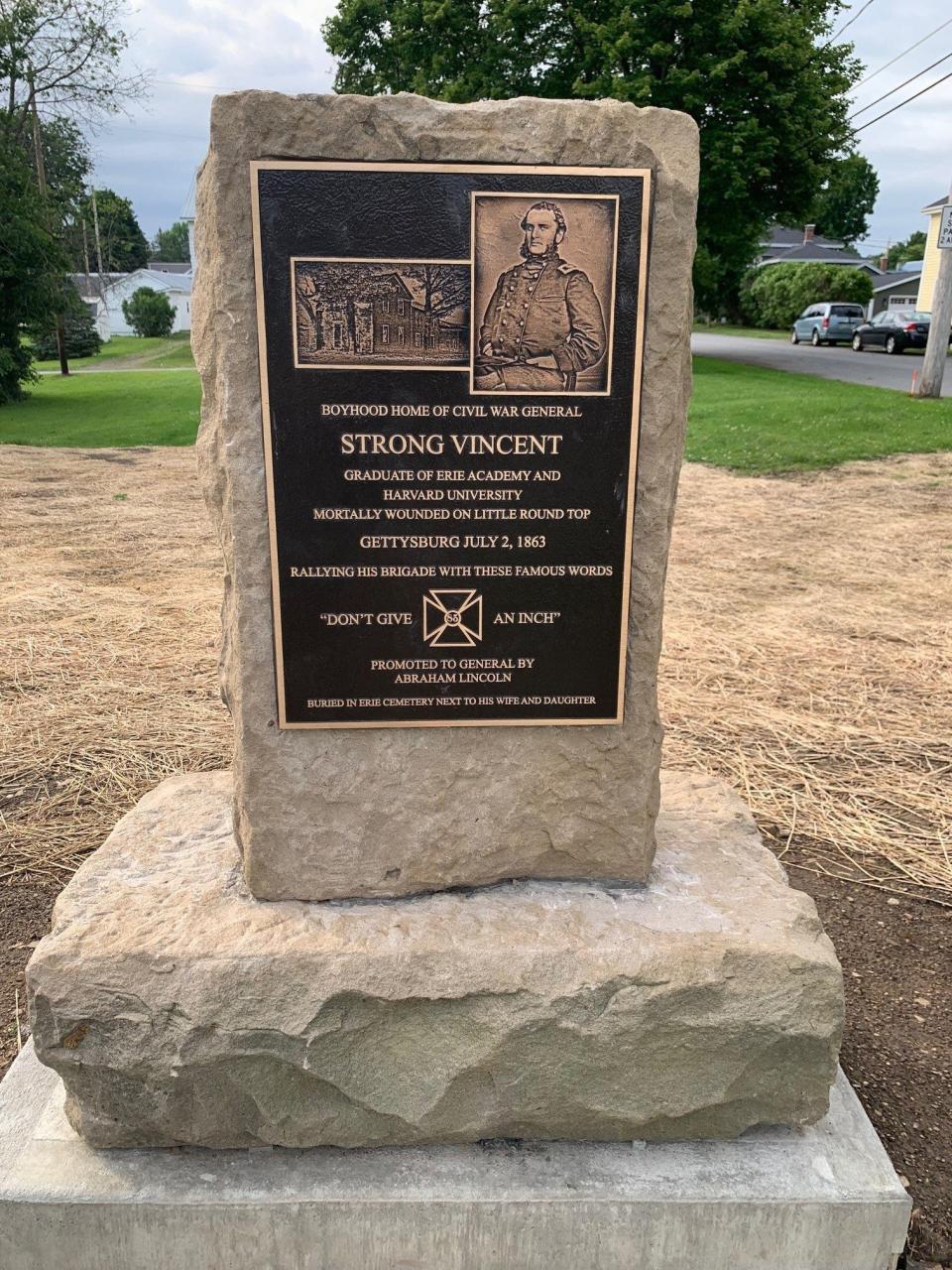Erie native Hans G. Myers' book aims to give Civil War hero Strong Vincent his due
- Oops!Something went wrong.Please try again later.
- Oops!Something went wrong.Please try again later.
From the foreword of author Hans G. Myers' "The Lion of Round Top: The Life and Military Service of Brigadier General Strong Vincent in the American Civil War," Frank Varney warns the reader that “the book you hold is going to make you reconsider something you were pretty sure was true.”

Varney indicates that a hero of Gettysburg is to be toppled from his lofty perch. As anyone with slight knowledge of that momentous three-day Civil War battle in July 1863 realizes, once we zero in on Little Round Top, that yet unnamed Col. Joshua Lawrence Chamberlain is the one in the author’s sights.
From popular books, documentaries and film, Chamberlain stands out as one of our great military heroes for his unorthodox and unwavering actions. This part of the story is easy to follow, even for non-historians: His men fought to the last musket ball and Chamberlain ordered them to fix bayonets and fight hand-to-hand to hold their position. As a result, they won the day on July 2, 1863, and, many have said, the war. However, this story does not focus on the tactical leader of that skirmish, but the operational one, largely forgotten in the popular mind, who told Chamberlain to hold the hill “at all hazards” in the first place.
Knowing the author originates from Erie (in fact, he is the son of Erie Times-News staff writer Valerie Myers) indicates a bias is inherent in the project from the outset. This was an important town in the development of Great Lakes shipping, but its story, like its native son Brig. Gen. Strong Vincent’s, has been forgotten outside of our region. Myers will do his best to convince us that Erie, as well as the man he calls “the Lion of Little Round Top,” have reason to roar.
The young Vincent, born in 1837, went to Trinity College in New Hampshire, where he met his future wife, Elizabeth Carter, a teacher at Miss Porter’s School. Vincent graduated from Harvard College and eventually became a respected lawyer, practicing in Erie. In 1859, Vincent enlisted in the Wayne Guards, the Erie militia company named for General “Mad” Anthony Wayne, which was mobilized in April 1861.
Vincent photo found:Hagen History Center finds hidden treasure, a rare original photograph of Strong Vincent
Vincent and Carter were married that same month. The Erie Weekly Gazette congratulated the couple with tragic but unwitting foreshadowing: “We trust he (Vincent) may safely return to his fair bride after filling the demands of his country upon his services, and thereafter enjoy long continued and uninterrupted domestic felicity.” The Vincents would not enjoy such domestic felicity in Erie, as he did not return from Gettysburg alive, dying on July 7, 1863.
Myers relates a description of Vincent "of medium stature, but well formed. He was a fine horseman, and when mounted looked much larger than when on foot.” This emphasis is unfortunate, as this larger stature made him such an excellent target on the battlefield.
The initial and re-muster of regiments and travel and supply of this Pennsylvania group provide a fascinating look into the process of mobilizing hundreds of thousands of men in a hurry. Logisticians, supply officers and lay readers alike will enjoy the descriptions of how to ready an army for a fight of this size and unanticipated duration from the perspective of a single regiment. The hurry-up-and-wait aspect common to all wars is clearly articulated.

Honoring Vincent:Memorial honors Civil War hero Strong Vincent in Waterford
One interesting component of the narrative is the vignette supplied about the warm welcome then-Lt. Col. Vincent’s 83rd Pennsylvania Regiment enjoyed from the enslaved people at a Virginia plantation near Yorktown that had been recently abandoned by its owner. The typical lack of inclusion of the role or even existence of African Americans in traditional recounting of Civil War battles is overcome here, providing, albeit with the expected contemporary descriptive epithets of those actors, a refreshing and modern perspective that complements the positive treatment of Vincent’s character. The swiftness and, perhaps, glee with which the enslaved provided useful information regarding the “disposition of Confederate forces near West Point” to the commander also underscores the importance of not discounting who might be your best sources of intelligence in the battlefield space.
While having been thus far elected to his various positions, Vincent was promoted to colonel only after leaving his sickbed, plagued with an unknown fever, to lead his regiment in retreat, though “delirious,” over the Chickahominy River, after hearing how many had already been lost in the skirmish. In further foreshadowing, Vincent fell from his horse in exhaustion and was carried from the field to recuperate in New York. Fortunately, he survived this occurrence.
As we return to the objective of this narrative, the correction of the historical record regarding who deserves the accolades as the “savior and hero of Little Round Top,” and the author argues, turning the tide of Gettysburg to enable Union victory in the entire Civil War, the author follows John Varney’s prescription for his book rehabilitating the legacy of Ulysses S. Grant.
Myers generously agrees that his work is not “an effort to slur or diminish the immense heroism and bravery of Chamberlain and his 20th Maine” and agrees that “(t)he laurels of Little Round Top are more than substantial enough to be passed around among the various claimants.” However, the salient pieces of evidence pointing to Chamberlain’s intentional self-aggrandizement are convincing. The most significant of all is the suggestion that Chamberlain’s own battlefield report, dated July 6, 1863, but having been discovered missing from the official record and requested verbatim by the War Department in 1884, was a newly minted revision of events.
Details that could not have been known on the original date, such as the deaths of two officers that occurred one and two weeks after July 6, as well as the report’s reference to “Little Round Top,” a moniker not in general parlance until well after the battle, give further credence to the likelihood that Chamberlain revised his report before submitting it. This, along with his own speaking tours and writings emphasizing his own outsized role, are certainly convincing that the modern view of Chamberlain as sole savior is exaggerated.
Vincent's legacy: Strong Vincent name, legacy will endure in the Erie community
Others have pointed to these discrepancies as do many whom the author highlights in the volume’s appendix. The larger burden of the work to convince the reader that Vincent is the true savior of Little Round Top is weightier. The American Battlefield Trust acknowledges that others “merited more credit than they received” including “Strong Vincent, who unhesitatingly put his brigade on Little Round Top and rallied that brigade under intense fire until he fell mortally wounded.” The Trust also notes that Col. Patrick O’Rorke and Brig. Gen. Gouverneur Warren are deserving of credit equal to Vincent.
It is now for lay readers to enjoy the story of the indisputably valiant and highly effective Col. Vincent, who was promoted to brigadier general after the battle, and for historians, as the author states, “to tilt at the windmills of truth” and determine who, if anyone, was the real Lion of Little Round Top.
About the book
Author: Hans G. Myers
Publisher: Casemate
Pages: 216
Release date: May 12
List price: $34.95
Meet the author
Hans G. Myers will appear at the Hagen History Center, 356 W. Sixth St., on June 19 from noon to 5 p.m. for a book signing as part of the Erie County Historical Society's free admission community day. "The Lion of Round Top" will be available for purchase, or patrons can take their own copy.
Myers is an Erie historian and rising doctoral student in history at Case Western Reserve University. He is a graduate of Thiel College (2019) and the University of Indianapolis (2021).
Diane Chido is founder of Erie-based research firm DC Analytics and a political science instructor with Gannon University.
This article originally appeared on Erie Times-News: 'Lion of Round Top' aims to give Civil War hero Strong Vincent his due

